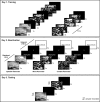Differential Left Hippocampal Activation during Retrieval with Different Types of Reminders: An fMRI Study of the Reconsolidation Process
- PMID: 26991776
- PMCID: PMC4798722
- DOI: 10.1371/journal.pone.0151381
Differential Left Hippocampal Activation during Retrieval with Different Types of Reminders: An fMRI Study of the Reconsolidation Process
Abstract
Consolidated memories return to a labile state after the presentation of cues (reminders) associated with acquisition, followed by a period of stabilization (reconsolidation). However not all cues are equally effective in initiating the process, unpredictable cues triggered it, predictable cues do not. We hypothesize that the different effects observed by the different reminder types on memory labilization-reconsolidation depend on a differential neural involvement during reminder presentation. To test it, we developed a declarative task and compared the efficacy of three reminder types in triggering the process in humans (Experiment 1). Finally, we compared the brain activation patterns between the different conditions using functional magnetic resonance imaging (fMRI) (Experiment 2). We confirmed that the unpredictable reminder is the most effective in initiating the labilization-reconsolidation process. Furthermore, only under this condition there was differential left hippocampal activation during its presentation. We suggest that the left hippocampus is detecting the incongruence between actual and past events and allows the memory to be updated.
Conflict of interest statement
Figures




References
-
- Sara SJ. Retrieval and reconsolidation: toward a neurobiology of remembering. Learn Mem. 2000;7(2):73–84. - PubMed
-
- Nader K, Schafe GE, Le Doux JE. Fear memories require protein synthesis in the amygdala for reconsolidation after retrieval. Nature. 2000;406(6797):722–6. - PubMed
-
- Milekic MH, Alberini CM. Temporally graded requirement for protein synthesis following memory reactivation. Neuron. 2002;36(3):521–5. - PubMed
Publication types
MeSH terms
LinkOut - more resources
Full Text Sources
Other Literature Sources
Medical
Miscellaneous

